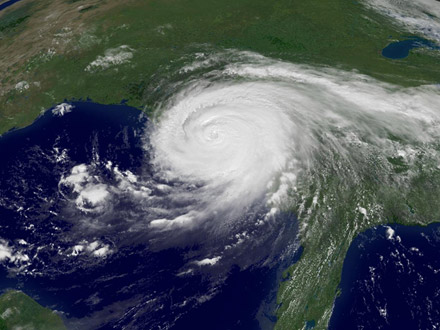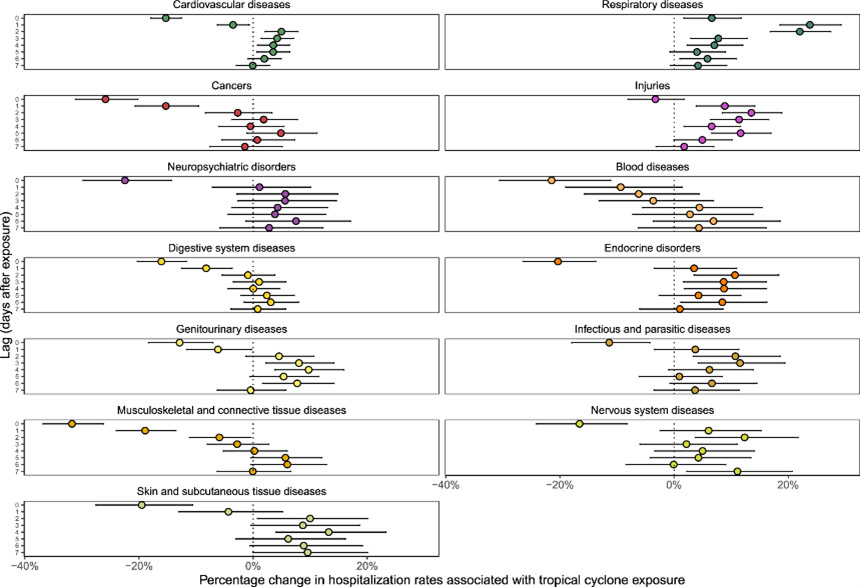By David Richards

Hospitalizations of older U.S. adults increased in the week following exposure to tropical cyclones, according to a new study funded by NIEHS . The researchers found nearly 17,000 additional hospitalizations were associated with tropical cyclone exposures over a 10-year average.
Exposure to winds from tropical cyclones, including tropical storms and hurricanes, can have severe health impacts . Further, climate change is likely increasing tropical cyclone intensity . This study is the first to explore their impacts on hospitalizations and health outcomes over a long period of time in the U.S.
"Tropical cyclones and hurricanes can have devastating impacts on society, particularly on the poorest and most vulnerable," said lead study author Robbie M. Parks, Ph.D., post-doctoral research fellow at Columbia University's Earth Institute. "Being able to quantify the health impacts in a robust way provides valuable information for how specific hospitalizations can be affected by these storms."

The researchers used data on 70 million Medicare hospitalizations for individuals 65 years and older and a comprehensive database of gale force winds, winds that exceed 34 knots (39 mph), in nearly 900 counties across 30 states to estimate tropical cyclone exposures between 1999 and 2014. The researchers then grouped hospitalizations into 13 main causes and 100 sub-causes of hospitalizations. In general, the most common causes of hospitalization were cardiovascular and respiratory diseases.
In the week following tropical cyclone exposure, average hospitalizations surged in several categories, including respiratory diseases, infectious and parasitic diseases, and injuries. Hospitalization rates for respiratory diseases, which saw the highest rise among the main causes, increased an average of 14% over the week, and within the category, chronic obstructive pulmonary disease increased 44.7%.
"One possible explanation for the large increases in certain acute conditions in the respiratory disease category is that it represents individuals with respiratory issues that rely on medical equipment to breathe," said Parks. "If electricity is cut, as can often happen with tropical cyclones, those individuals may seek immediate respiratory aid."
Average increases in hospitalizations for respiratory diseases and injuries peaked within 1-3 days of tropical cyclone exposure. When the researchers examined wind speeds of hurricane force, greater than 64 knots (74 mph), the impacts of exposure were more severe. Average respiratory disease hospitalizations doubled, and injury hospitalizations rose 41% on their respective peak days.
Injury hospitalizations can include pedestrian or transportation accidents due to collapse of buildings, wind-borne debris, or falling power lines or trees. They can also occur days after the event during recovery efforts in the form of overexertion, sprains, or falls.
In total, the researchers estimated that in the 30 states analyzed, tropical cyclone exposures could contribute nearly 17,000 additional hospitalizations per decade on the day of and up to seven days following the event.

Percent change in hospitalization rates in 13 main causes associated with tropical cyclone exposure. Click image to enlarge.
(Photo courtesy of Nature Communications)
While the overall increases were primarily driven by emergency hospitalizations, the researchers found that nonemergency hospitalizations slightly decreased after tropical cyclone exposure. Average cardiovascular disease hospitalizations declined on the day of and day after exposure but then returned to normal within 2-7 days. Average cancer-related hospitalizations decreased 4.4% in the week following a tropical cyclone.
According to the authors, patients may delay seeking medical treatment to avoid the immediate risks from tropical cyclone exposures. Further, access to transportation or power outages may prevent individuals from getting to a hospital.
Implications for Vulnerable Populations and Emergency Preparedness
The North Atlantic had an all-time high of 30 named tropical cyclones in 2020. Their accumulated cyclone energy, a way to measure intensity, was 75% above normal, according the National Oceanic and Atmospheric Administration.
"Things may get worse under climate change," said Parks. "What we do know is that hurricanes and other tropical cyclones are here to stay. We need to figure out how best to prepare for them and who is most vulnerable. This is also an issue of environmental and social justice, because many of those impacted are in low-income and historically disadvantaged communities."
Older adults are particularly vulnerable to the effects of tropical cyclones. Older adults are more likely to suffer from chronic illnesses and cognitive decline, and exposure to tropical cyclones can worsen those existing health issues.
The researchers noted that study results can inform hospital and physician preparedness strategies. For example, hospitals could set up shelters that provide electricity and common medications and help vulnerable individuals with chronic conditions find and use those resources outside of the hospital.
"Our study is a first step in identifying areas of improvement in hospital preparation," said Parks. "This detailed analysis may also help disaster preparedness experts further improve their work by being able to better understand health outcomes before tropical cyclones hit."
NIEHS Focus on Extreme Weather Events and Climate-related Disasters
The intersection of climate and disasters, including tropical cyclone and hurricane research, is of growing interest to the environmental health sciences community. NIEHS funds climate change research and manages the Climate Change and Human Health Literature Portal , a database of global peer-reviewed research and gray literature on the science of climate impacts on human health. The Literature Portal allows researchers to curate global scientific literature based on dozens of topics within the field, which include natural disasters.
A major element of NIEHS' climate change and disaster research efforts is the NIH Public Health Emergency and Disaster Research Response (DR2). The NIH DR2 Program, led by NIEHS, aims to promote coordinated environmental health disaster research data collection tools and a network of trained research responders. The DR2 Program recently redesigned their website and launched a new DR2 Tools and Resource Portal, which complements the Literature Portal. The DR2 Portal includes hundreds of data collection tools to aid researchers study the health impacts of disasters.
Citation: Parks RM, Anderson GB, Nethery RC, Navas-Acien A, Dominici F, Kioumourtzoglou MA. 2021. Tropical cyclone exposure is associated with increased hospitalization rates in older adults. Nat Commun 12(1):1545.

